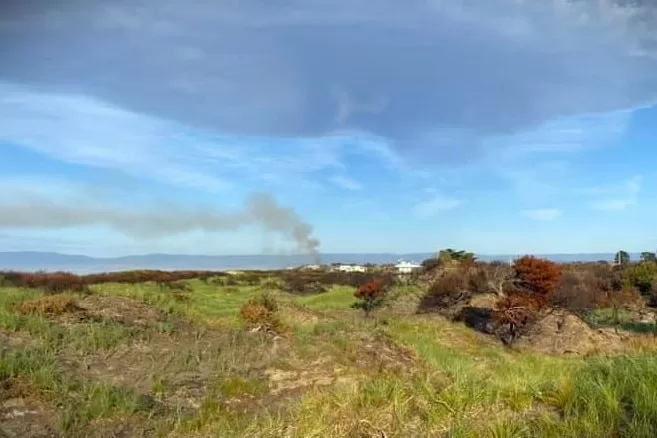A blaze threatening a community on Tasmania’s east coast has been successfully extinguished, in part due to the Tasmania Fire Service’s (TFS) dedicated firefighting aviation fleet.
The TFS was called to Dolphin Sands, a coastal community near the popular Freycinet Peninsula, at about 7:15am today, where a vegetation fire on the ocean side of the town was burning.
The warning was quickly escalated to Watch and Act and authorities urged hose in the area to take action to protect themselves, their loved ones and homes.
Nine waterbombing aircraft — the type first deployed in Tasmania to fight the 2013 Dunalley bushfires — helped bring the fire under control.
Deputy Chief Officer of the Tasmania Fire Service Matt Lowe told ABC Mornings the fire service had “hit it with everything we’ve got”, including both ground and aerial crews.
Many in the small Dolphin Sands community are still wary of blazes after the bushfire in November last year destroyed two homes and forced two dozen people to evacuate and shelter at a local jetty.
“We’re always on high alert for fire, and there’s quite a bit of trauma still from the last fire, so people are quite anxious,” local resident Robyn Moore said.
“We’re feeling really good [after today’s fire was extinguished].
“Of course, we can’t relax completely, but we’ve just had really great air support from TFS, who have hit the fire really hard.”
Ms Moore said grass lit by sparks from a transformer might have caused the fire.
Planes a farming tool that work ‘very well’ in firefighting
Aviation expert Neil Hansford said Australia was constantly upgrading its aerial firefighting capacity.
He said the “air tractors” that had been used “for decades” in the farming industry to spray crops had remained a reliable option.
“They don’t have major modifications like a lot of multi-use aircraft, and they have performed very well,” Mr Hansford said.
Mr Hansford said the pilots were highly skilled and generally older and experienced.
He said the planes themselves were a “rugged-construction aeroplane” with a single pilot, basic technology and a “very powerful engine”.
“Basically, [crews] are very well briefed, they’ve got very good charts that generally go on very defined missions,” he said.
“They can get to the heart of the fire, which may be difficult for people on the ground, and the main thing they do is spray retardant or they narrow the fire down until ground-based firefighters can get to it and totally extinguish it.”
Mr Hansford said the aircraft also put out spot fires when going to and from missions.
Expanded specialised air fleet on stand by
The TFS’s Matt Lowe said the service’s fleet of specialised aircraft had expanded to 15 — three more than last bushfire season — as part of the state’s bushfire response plan put into action this year.
Mr Lowe said two models of “air tractors” had been continuously contracted in Tasmania since their deployment during fires that devastated Dunalley in 2013, destroying 93 homes.
In 2018, the aircraft were also used to fight bushfires that burned through thousands of hectares of UNESCO world heritage wilderness in Tasmania’s south-west.
Mr Lowe said one air tractor could drop 3,000 litres of water before needing to be refilled, and another could scoop up water from any nearby water body to help it extinguish the blaze.
“Aerial firefighting continues to be a key part of our bushfire response, hitting the fires hard and fast to keep them as contained as possible until our ground crews can access the scene, and getting vital information from above to help our ground crews plan and strategise,” Mr Lowe said.
But he said Tasmanians needed to remain vigilant.
“I’m confident in our ability to respond to bushfires this season but it’s important for people to know that having these aircraft on hand doesn’t mean we as a community can sit back and relax,” he said.
He reiterated the TFS’s “clear message” on bush fire preparedness to the public.
“It’s around being prepared, whether you’re at home or on your own property, whether your at home or at your shacks,” Mr Lowe said.
“People need to have situational awareness of where they are, where they find their information, what to do if they happen to have a fire in that area.”
LoadingLoading…
